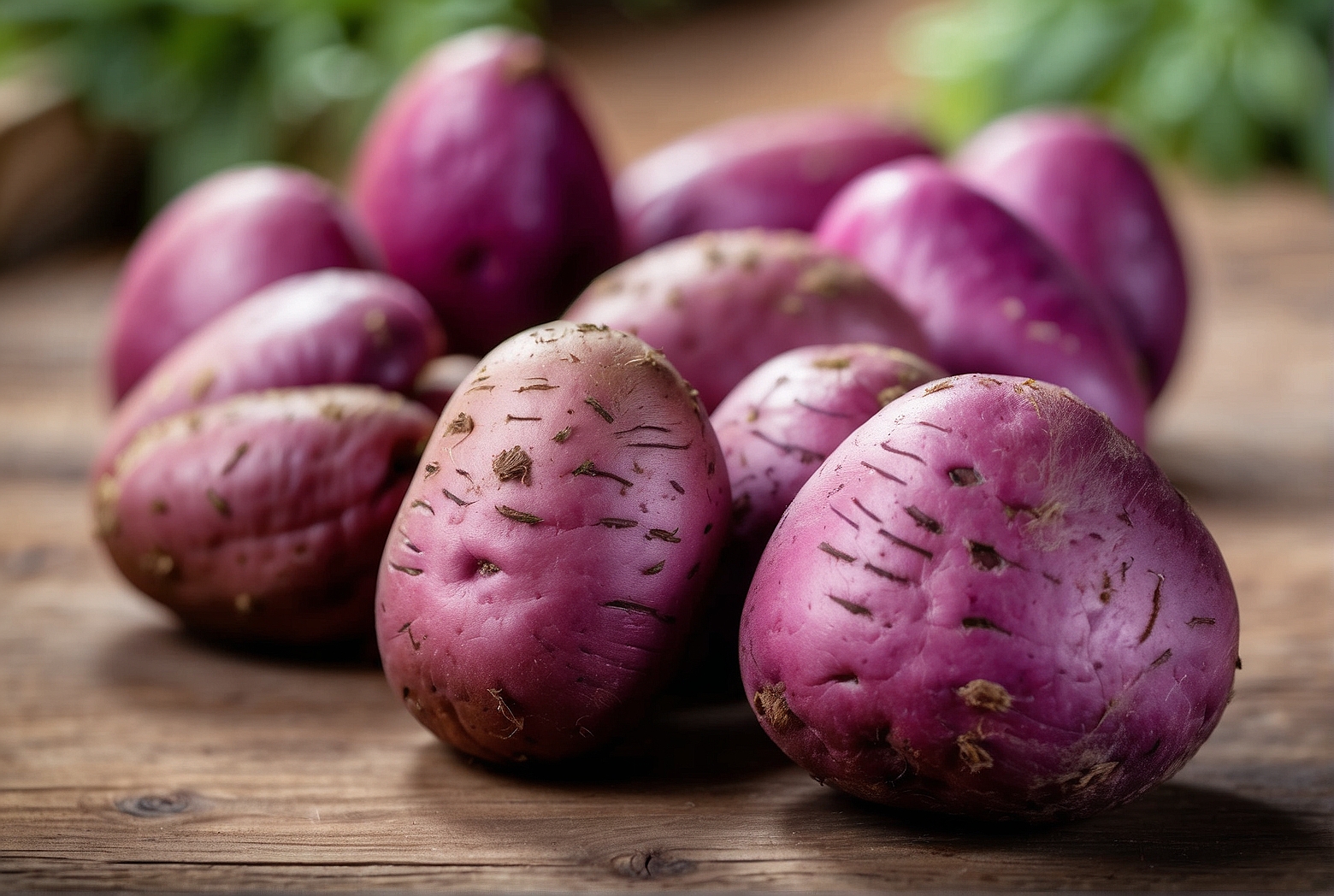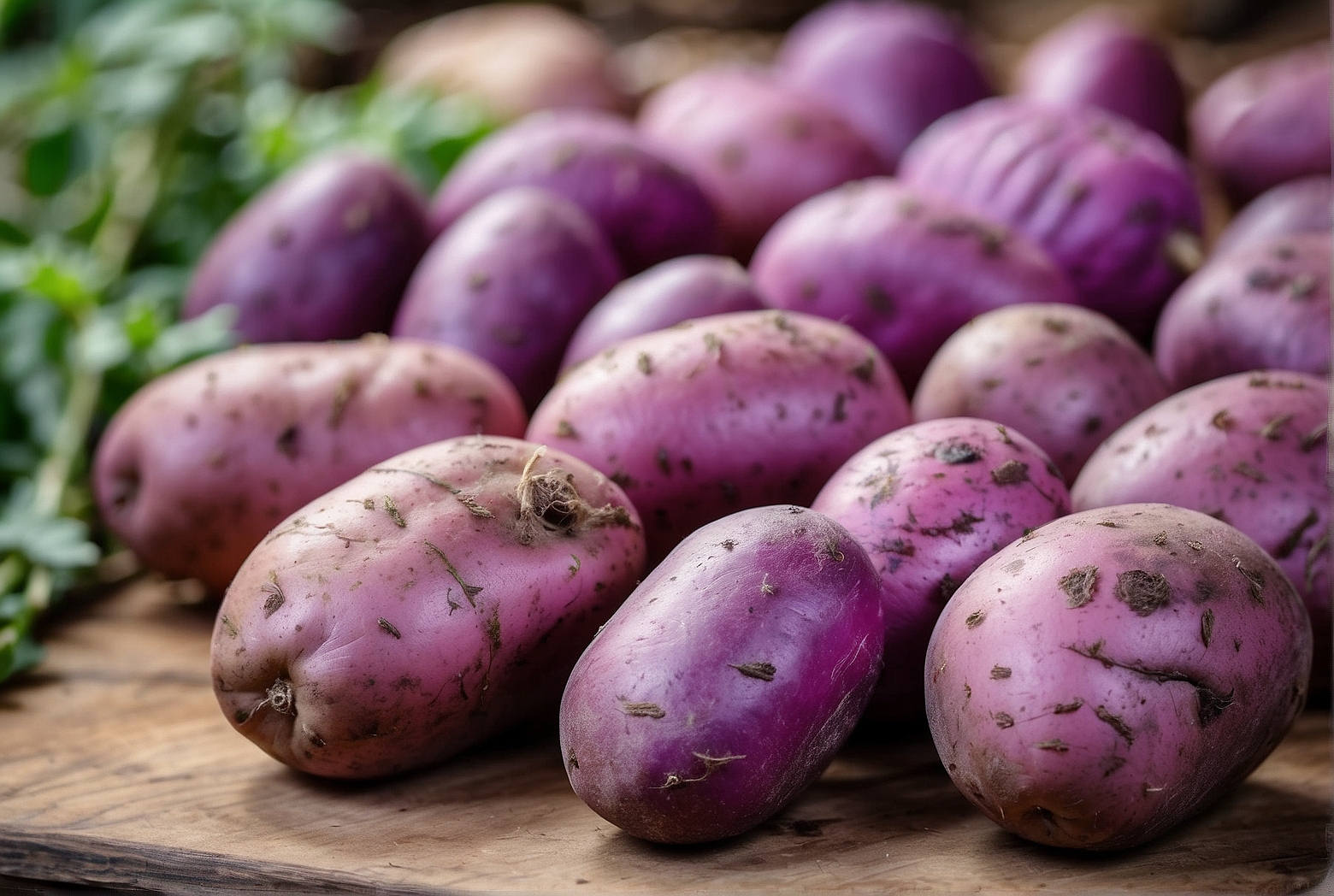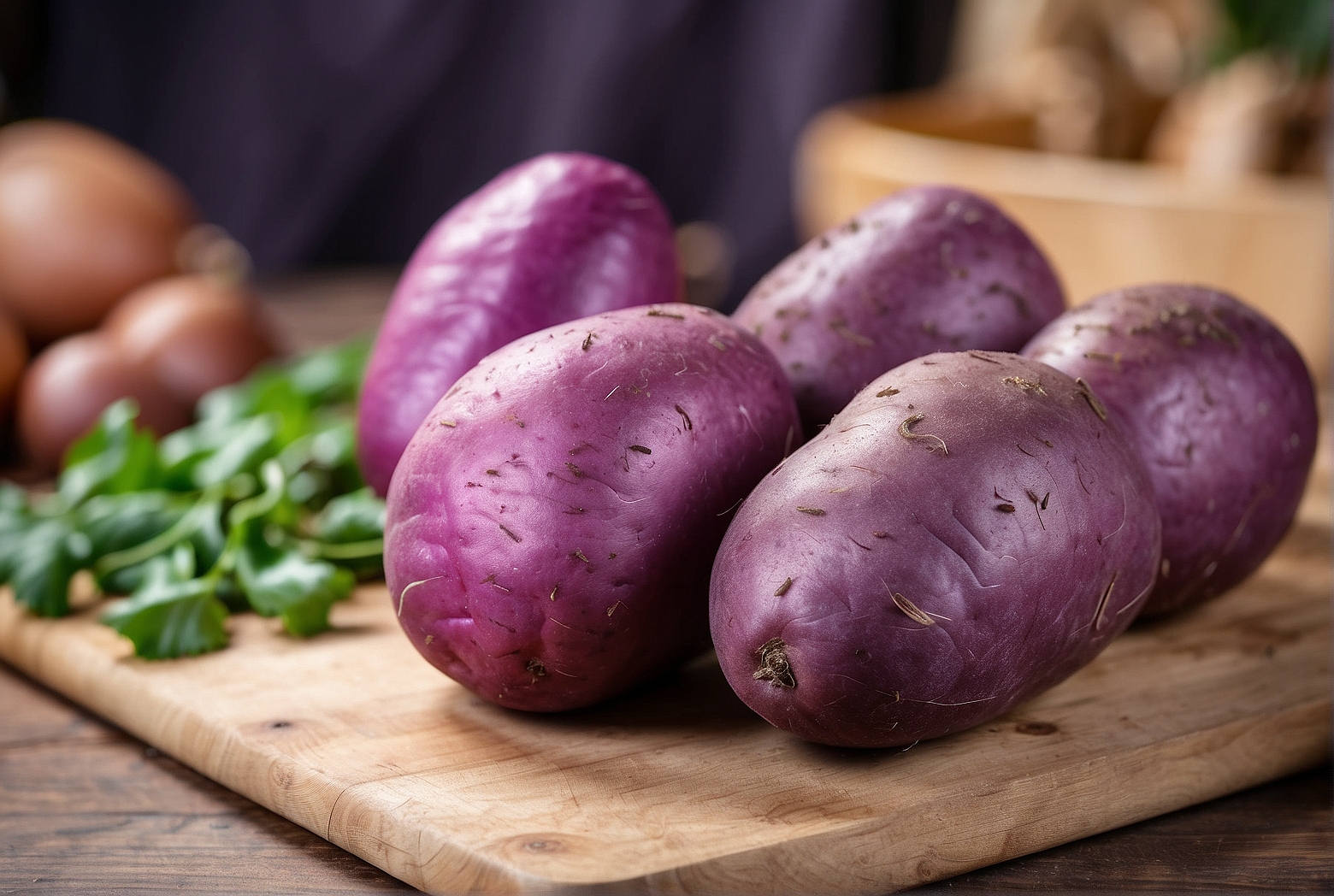Last Updated on April 9, 2024 by Tony Manhart
Have you ever heard of the Purple Viking Potato? If not, get ready to discover a fascinating determinate variety that will add a burst of color to your garden. With its vibrant purple skin and creamy white flesh, this potato not only stands out visually but also offers unique characteristics that make it a must-have for any potato lover. In this article, we will explore the intriguing features of the Purple Viking Potato and why it is worth considering for your next planting season. Get ready to be captivated by the allure of this exceptional tuber.
Introduction
What is the Purple Viking Potato
The Purple Viking Potato is a unique and eye-catching variety of potato that boasts a vibrant purple skin and a creamy white flesh. It is known for its attractive appearance and delicious taste, making it a popular choice among both gardeners and chefs. In this article, we will explore the characteristics of the Purple Viking Potato, its growth habits, ideal growing conditions, planting and care tips, as well as its culinary uses. Whether you are a seasoned gardener or a potato enthusiast looking to try something new, this article will provide you with all the information you need to grow and enjoy this remarkable potato variety.
Determinate vs. Indeterminate Varieties
Before we delve into the details of the Purple Viking Potato, it’s important to understand the difference between determinate and indeterminate varieties. Determinate varieties, as the name suggests, have a fixed growth pattern and reach a predetermined size. On the other hand, indeterminate varieties have a more sprawling growth habit and can continue to grow and produce tubers until the plant is killed by frost or extreme conditions. Understanding the growth habits of potato varieties can help gardeners and farmers plan their planting and harvesting schedules effectively.
Purpose of the Article
The purpose of this article is to provide a comprehensive guide to the Purple Viking Potato, focusing on its characteristics, growth habits, ideal growing conditions, planting and care tips, advantages over indeterminate varieties, culinary uses, and availability. By the end of this article, you will have a thorough understanding of the Purple Viking Potato and be equipped with the knowledge to grow, cook, and appreciate this exceptional potato variety.

Characteristics of Purple Viking Potato
Appearance
The Purple Viking Potato is undoubtedly a showstopper with its striking purple skin and pink splashes. Its oblong to round shape adds to its appeal, making it a visually captivating addition to any potato dish. When cooked, the purple skin fades to a beautiful lavender hue, creating a lovely contrast with the creamy white flesh. Slice it open, and you will be greeted with an array of colors that are sure to impress even the most discerning palates.
Flavor Profile
In addition to its stunning appearance, the Purple Viking Potato also excels in flavor. Its flesh is moist, buttery, and slightly sweet, providing a delicate and rich taste. This combination of flavors makes the Purple Viking Potato suitable for a wide range of culinary applications, from simple roasted potatoes to mashed, fried, or even turned into colorful chips. Its versatility in the kitchen is one of the reasons why this potato variety has gained popularity among both home cooks and professional chefs.
Nutritional Value
Not only does the Purple Viking Potato please the senses with its appearance and taste, but it also offers a range of health benefits. Like other potatoes, it is a good source of vitamins such as vitamin C and B6, as well as minerals like potassium and manganese. It also provides dietary fiber, which aids in digestion and helps maintain a healthy gut. Incorporating Purple Viking Potatoes into your diet can be a nutritious and delicious way to enhance your overall well-being.
Life Cycle and Growth Habit
Determinate vs. Indeterminate Growth
As previously mentioned, understanding the growth habits of potato varieties is crucial for successful cultivation. Determinate potato varieties, including the Purple Viking Potato, have a predictable growth pattern. They produce tubers during a specific time frame and reach their full potential within a relatively short period. In contrast, indeterminate potato varieties continue to grow and produce tubers as long as the plant remains healthy and the conditions are favorable.

Purple Viking Potato’s Growth Habit
The Purple Viking Potato is a determinate variety, which means it follows a specific growth pattern. From planting to maturity, the Purple Viking Potato takes approximately 75 to 90 days, depending on the growing conditions. The plants are vigorous and compact, reaching a height of around 18 to 24 inches. This compact growth habit makes them well-suited for smaller garden spaces, containers, or raised beds.
Factors Affecting Growth
Several factors can affect the growth of the Purple Viking Potato. Firstly, the quality of the soil plays a crucial role in providing the necessary nutrients for the plants to thrive. Additionally, the availability of sunlight, water, and the appropriate temperature range are vital for healthy growth and tuber development. It is important to consider these factors and provide the optimal conditions to ensure a successful harvest.
Ideal Growing Conditions
Temperature and Climate
The Purple Viking Potato thrives in cooler climates, with temperatures between 60°F and 70°F (15°C – 21°C) being optimal for its growth. While it can tolerate light frosts, it is best to plant them after the threat of severe frost has passed. In regions with hot summers, planting during the cooler months or providing partial shade can help mitigate the heat stress on the plants.
Soil Requirements
To achieve the best results with the Purple Viking Potato, it is essential to have well-draining soil. The soil should be loose, fertile, and rich in organic matter, ensuring proper aeration and allowing the roots to grow and access nutrients effectively. The pH level of the soil should be slightly acidic, preferably ranging from 5.5 to 6.5, to promote optimal nutrient uptake by the plant.
Sunlight and Watering
Similar to other potato varieties, the Purple Viking Potato thrives in full sun. Providing at least six to eight hours of direct sunlight each day will help the plants generate energy through photosynthesis, leading to robust growth. Adequate watering is also crucial for the Purple Viking Potato, as it requires consistent soil moisture throughout its life cycle. However, overwatering should be avoided, as it can lead to waterlogged soil and rotting tubers.
Planting and Care
Selection of Seed Potatoes
When it comes to selecting seed potatoes for planting, it is recommended to choose certified disease-free tubers. This ensures that your plants start off on the right foot and reduces the risk of potential diseases or pests. Look for firm, healthy seed potatoes without any signs of decay or sprouting. It is also advisable to select seed potatoes that are of medium size, as larger ones may produce more foliage but smaller tubers.
Planting Techniques
To plant the Purple Viking Potato, start by preparing the soil by removing any weeds or debris and loosening it with a garden fork or tiller. Dig trenches or holes about 4-6 inches deep and place the seed potatoes with the “eyes” facing upward, spacing them approximately 12-15 inches apart. Cover the seed potatoes with soil, forming mounds or ridges above the ground to encourage proper tuber development. Water the newly planted potatoes thoroughly and continue to provide consistent moisture throughout their growth.
Fertilization and Weed Control
Regular fertilization is essential for the healthy growth of the Purple Viking Potato. Before planting, incorporate organic matter, such as compost, into the soil to enrich its nutrient content. As the plants grow, apply a balanced fertilizer high in phosphorus and potassium, which promotes tuber development. It is important to follow the recommended dosage and application instructions on the fertilizer packaging. Additionally, regular weeding is vital to reduce competition for nutrients and optimize the growth of the potato plants.
Pest and Disease Management
While the Purple Viking Potato is relatively resistant to diseases and pests, it is still important to monitor for any signs of trouble. Common potato pests, such as aphids, potato beetles, and wireworms, can pose a threat to the plants. Using organic pest control methods, such as introducing beneficial insects or applying natural insecticides, can help manage these pests effectively. Disease prevention can be achieved by practicing crop rotation, ensuring proper plant spacing, and promptly removing any diseased plants to prevent the spread of infections.
Harvesting
Harvesting the Purple Viking Potato is an exciting and rewarding experience. Determine the optimal harvesting time by observing the foliage of the plants. When the foliage turns yellow and begins to die back, it is an indication that the tubers are mature. Carefully dig around the plants using a fork or shovel, being careful not to damage the tubers. Gently remove the Purple Viking Potatoes from the soil, brush off any excess dirt, and allow them to cure in a cool, dry place for a week before storing or using them in your favorite recipes.
Advantages of Determinate Varieties
Defined Harvest Time
One of the advantages of determinate potato varieties, such as the Purple Viking Potato, is their defined harvest time. Unlike indeterminate varieties that continue to produce tubers, determinate varieties allow for a more precise planning of the harvest. This makes it easier to schedule and ensures that you can enjoy a bountiful and timely potato harvest.
Compact Growth Habit
The compact growth habit of determinate varieties, including the Purple Viking Potato, is another advantage. Their smaller size makes them ideal for gardeners with limited space or those who prefer to cultivate potatoes in containers or raised beds. The compact growth habit also simplifies maintenance tasks, such as watering, fertilization, and pest control, as the plants are more contained and easier to manage.
Easier Harvesting
Due to their predetermined growth pattern, determinate varieties like the Purple Viking Potato offer the advantage of easier harvesting. Since the tubers are produced within a specific time frame, there is less need to dig through expansive potato beds in search of mature tubers. This saves time and effort, allowing gardeners to enjoy a more efficient and enjoyable potato harvesting experience.
Comparison with Indeterminate Varieties
Indeterminate Growth and Harvesting Challenges
While determinate varieties have their advantages, indeterminate potato varieties also have their merits. However, their sprawling growth habit can present challenges when it comes to harvesting. Indeterminate varieties produce tubers continuously, which means the plants can become quite large and spread out over time. This can make it more difficult to locate and harvest all the tubers, potentially leading to some being left behind in the soil.
Yield Differences
Yield is another factor to consider when comparing determinate and indeterminate potato varieties. Determinate varieties, including the Purple Viking Potato, tend to have a higher yield per plant. Since they focus their energy on producing tubers within a specific time frame, they can often produce more per plant compared to indeterminate varieties. This higher yield can be advantageous for those looking to maximize the harvest in a limited space.
Preference and Market Demand
The choice between determinate and indeterminate potato varieties ultimately depends on personal preference and market demand. Some gardeners and farmers prefer the controlled growth and defined harvesting time of determinate varieties, while others appreciate the continuous production and longer harvesting period of indeterminate varieties. It’s important to consider your specific needs, culinary preferences, and the demand in your local market when deciding which potato variety to cultivate.
Culinary Uses of Purple Viking Potato
Cooking Methods
The Purple Viking Potato’s unique flavors and beautiful colors make it a versatile ingredient that can be enjoyed in various culinary preparations. It can be boiled, steamed, roasted, or mashed to create delicious side dishes that will impress your friends and family. The creamy texture of the Purple Viking Potato makes it perfect for mashing, while its vibrant colors can add an artistic touch to roasted or grilled potato dishes.
Recipes and Dishes
When it comes to culinary creativity, the possibilities with the Purple Viking Potato are endless. It can be used in classic potato salads, colorful potato bakes, or even turned into vibrant purple gnocchi. You can also slice the Purple Viking Potato and make crispy homemade potato chips that not only taste great but also look visually appealing. With its delicious flavor and stunning appearance, this potato variety can elevate any dish it is used in.
Unique Qualities in Culinary Applications
One of the unique qualities of the Purple Viking Potato is its ability to retain its vibrant purple color even after cooking. This makes it an excellent choice for adding a pop of color and visual interest to any dish. Additionally, its creamy texture and slightly sweet flavor make it a delightful addition to both savory and sweet recipes. Whether you are preparing comfort food classics or experimenting with new and innovative dishes, the Purple Viking Potato is sure to add a touch of excitement to your culinary creations.
Availability and Suppliers
Nurseries and Seed Banks
Finding the Purple Viking Potato for your own garden can be an exciting endeavor. One way to acquire seed potatoes is to visit local nurseries and garden centers. These establishments often carry a variety of potato cultivars, including the Purple Viking Potato, during the planting season. Check with your local nurseries to see if they have this unique variety available or if they can recommend other reputable garden suppliers in the area.
Online Sources
The internet provides a wealth of options for sourcing seed potatoes, including the Purple Viking Potato. Numerous online seed banks and specialty vegetable suppliers offer a wide variety of potato cultivars for purchase. Research and read reviews to find reliable and trusted online sources that provide high-quality seed potatoes. When ordering online, it is important to consider shipping costs, delivery times, and any specific planting instructions provided by the supplier.
Conclusion
Final Thoughts
The Purple Viking Potato is an extraordinary potato variety that captivates both the eyes and taste buds. Its vibrant purple skin, creamy white flesh, and versatile culinary uses make it a standout choice for gardeners and chefs alike. Understanding its determinate growth habit, ideal growing conditions, planting and care tips, and advantages over indeterminate varieties is essential for successfully cultivating this extraordinary potato.
Considerations for Gardeners and Farmers
As you embark on your journey to grow the Purple Viking Potato, consider the space available, the local climate, and your personal preferences. Evaluate the benefits of determinate varieties, such as the defined harvest time and compact growth habit, as well as the challenges and advantages of indeterminate varieties. Regardless of your choice, the Purple Viking Potato will surely add a touch of color and flavor to your garden and culinary creations. Happy potato growing and bon appétit!
Tony Manhart is a passionate gardener who has been tending to gardens for over 20 years. He takes pride in creating beautiful outdoor spaces with plants, trees, and shrubs that can thrive in any environment. He loves to share his knowledge with others and has taught classes on gardening basics and advanced techniques. He is committed to sustainability, using natural and organic methods to create and maintain gardens. He also works with local organizations to create green spaces for communities. When he’s not gardening, Tony enjoys hiking, reading, and spending time with his family.


